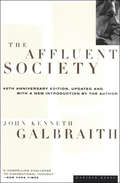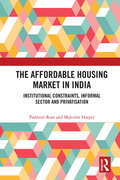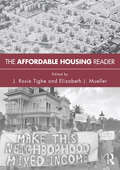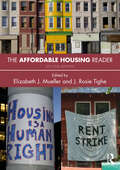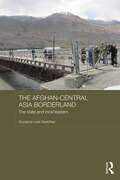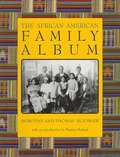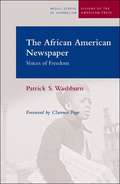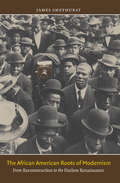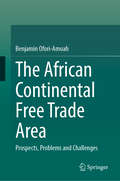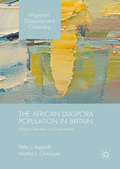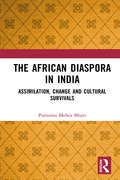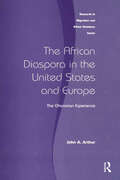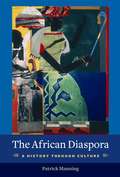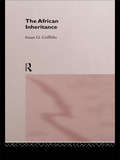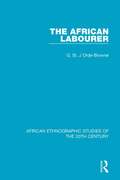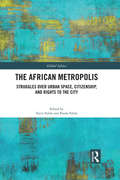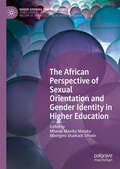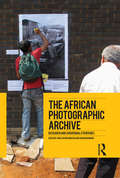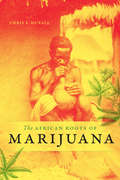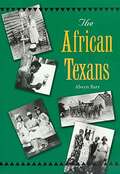- Table View
- List View
The Affluent Society: The Affluent Society And Other Writings, 1952-1967 - American Capitalism; The Great Crash, 1929; The Affluent Society; The New Industrial State (Penguin Economics Ser.)
by John Kenneth GalbraithThe classic by the renowned economist: &“One of those rare works that forces a nation to re-examine its values&” (The New York Times). One of the New York Public Library&’s &“Books of the Century&” Hailed as a &“masterpiece&” (St. Louis Post-Dispatch), this examination of the &“economics of abundance&” cuts to the heart of what economic security means (and doesn&’t mean) and lays bare the hazards of individual and societal complacence about economic inequity. The book that introduced the phrase &“conventional wisdom&” to our vernacular, The Affluent Society is as timely today as when it was first published. &“Warrants careful reading by every thoughtful person.&” —The Christian Science Monitor
The Affordable Housing Market in India: Institutional Constraints, Informal Sector and Privatisation
by Malcolm Harper Padmini RamThis book examines the housing crisis in India and underlines the need for formal affordable housing markets. India is home to the world’s largest population of slum dwellers. The book examines actual causes of the problem, and the financial and political issues which underlie it. The volume: Analyses multiple perspectives on affordable housing from the points of view of slum dwellers, builders, facilitators, bureaucrats, and politicians Presents a fresh overview of the housing sector in India based on the conditions of slum dwellers in a typical, medium-sized, fast-growing city – Raipur, in the state of Chhattisgarh Puts forward radical conclusions, practical solutions, and policy recommendations for a formal affordable housing market in India This will be a major intervention for scholars and researchers of urban sociology, built environment, public policy, development studies, economics, political economy, institutional economics, and urban studies as well as policymakers, planners, and professionals in the urban development sector.
The Affordable Housing Reader
by J. Rosie Tighe Elizabeth J. MuellerThe Affordable Housing Reader brings together classic works and contemporary writing on the themes and debates that have animated the field of affordable housing policy as well as the challenges in achieving the goals of policy on the ground. The Reader – aimed at professors, students, and researchers – provides an overview of the literature on housing policy and planning that is both comprehensive and interdisciplinary. It is particularly suited for graduate and undergraduate courses on housing policy offered to students of public policy and city planning. The Reader is structured around the key debates in affordable housing, ranging from the conflicting motivations for housing policy, through analysis of the causes of and solutions to housing problems, to concerns about gentrification and housing and race. Each debate is contextualized in an introductory essay by the editors, and illustrated with a range of texts and articles. Elizabeth Mueller and Rosie Tighe have brought together for the first time into a single volume the best and most influential writings on housing and its importance for planners and policy-makers.
The Affordable Housing Reader
by J. Rosie Tighe Elizabeth J. MuellerThis second edition of The Affordable Housing Reader provides context for current discussions surrounding housing policy, emphasizing the values and assumptions underlying debates over strategies for ameliorating housing problems experienced by low-income residents and communities of color. The authors highlighted in this updated volume address themes central to housing as an area of social policy and to understanding its particular meaning in the United States. These include the long history of racial exclusion and the role that public policy has played in racializing access to decent housing and well-serviced neighborhoods; the tension between the economic and social goals of housing policy; and the role that housing plays in various aspects of the lives of low- and moderate-income residents. Scholarship and the COVID-19 pandemic are raising awareness of the link between access to adequate housing and other rights and opportunities. This timely reader focuses attention on the results of past efforts and on the urgency of reframing the conversation. It is both an exciting time to teach students about the evolution of United States’ housing policy and a challenging time to discuss what policymakers or practitioners can do to effect positive change. This reader is aimed at students, professors, researchers, and professionals of housing policy, public policy, and city planning.
The Afghan-Central Asia Borderland: The State and Local Leaders (Central Asian Studies)
by Suzanne Levi-SanchezBased on extensive, long-term fieldwork in the borderlands of Afghan and Tajik Badakhshan, this book explores the importance of local leaders and local identity groups for the stability of a state’s borders, and ultimately for the stability of the state itself. It shows how the implantation of formal institutional structures at the border, a process supported by United Nations and other international bodies, can be counterproductive in that it may marginalise local leaders and alienate the local population, thereby increasing overall instability. The study considers how, in this particular borderland where trafficking of illegal drugs, weapons and people is rampant, corrupt customs and border personnel, and imperfect new institutional arrangements, contributed to a complex mix of oppression, hidden protest and subtle resistance, which benefitted illicit traders and hindered much needed humanitarian work. The book relates developments in this region to borderlands elsewhere, especially new borders in the former Soviet bloc, and argues that local leaders and organisations should be given semi-autonomy in co-ordination with state border forces in order to increase stability and the acceptance of the state.
The Africa Rising Discourse: Tropes, Trophies and Social Actors (Routledge Contemporary Africa)
by Tracy TingaOver the last 25 years, the "Africa Rising" discourse has been used to signify hope and promise for the continent, marking a break from previous pessimistic portrayals. This book critically examines that discourse, analyzing recurring themes, tropes, metaphors, and imagery.It traces the evolution of the "Africa Rising" discourse and its connection with Afro-pessimism, providing valuable insights into how the continent is represented and understood. The book explores the tensions, contradictions and impacts of labeling Africa as "rising". Focusing on both local and global social actors, as well as geopolitical influences, it examines how these forces have shaped the discourse over time. Additionally, it highlights how African actors have engaged with and modified the discourse. For instance, the book assesses how in recent years digital media platforms have offered spaces for counternarratives that challenge stereotypical representations, leading to a more nuanced and diverse understanding of Africa’s rise.This book offers valuable insights for researchers in Media and Communication Studies, Digital Media, Journalism, African Studies, and Global Studies.
The African American Family Album
by Dorothy Hoobler Thomas HooblerThe African American Family Album is a collection of the memories and experiences of a people who were first Africans, then slaves, and finally African Americans. Unlike most other immigrants to this country, the majority of Africans were brought to America against their will. The first slaves from Africa arrived in the Americas in the 16th century. Over the next 450 years, it is estimated that more than 11 million Africans (some think as many as 40 million) were taken from their homeland in the largest forcible movement of people in history. Torn from Africa, chained and forced to endure the "middle passage" to their new country, destined for a lifetime of slavery--this was the historical beginning of the American experience for most of today's African Americans. But there are cases of Africans who avoided or escaped that fate to becomes explorers and pioneers in the New World. Those fortunate few are also part of The African American Family Album, as are the 4 million African Americans who found themselves newly freed at the end of the Civil War. Their struggles to gain financial independence were thwarted by prejudice and hatred, and the enforced separation of the races. With little political or economic power, many found freedom to be but one step above slavery. The Great Migration between 1910 and 1950 brought millions from the tenant farms and towns of the South to settle in northern cities, one of the greatest population shifts the United States has ever experienced. This migration was one African Americans chose to make themselves. They moved for the same reasons that have brought other immigrant groups to the United States--to escape persecution and injustice and to find a better life. In the process, African Americans brought with them the blues, jazz, and gospel music that were to transform the culture of America. In cities and in the rural areas, in both the North and South, family loyalty, religion, and finally a movement for civil rights that brought purpose and hope to millions became key elements that held the African American family together. In their own words--from interviews, letters, diaries, newspaper articles, and published writings--the story of the African American unfolds in this moving and significant Family Album. Photographs culled from archives, news sources, and family collections make the history that is told here real and immediate. Profiles of Sojourner Turth, Booker T. Washington, W. E. B. Du Bois, Toni Morrison, and other notable African Americans are included, as are the words of such famous figures as Jackie Robinson, Spike Lee, Langston Hughes, Hank Aaron, Ralph Abernathy, and many others less famous who also proudly call themselves African Americans. They bring the story up to date, and reinforce the importance of their African roots to today's African American. Their history is part of our country's story now, and an important component in the great American Family Album. <P><P><i>Advisory: Bookshare has learned that this book offers only partial accessibility. We have kept it in the collection because it is useful for some of our members. Benetech is actively working on projects to improve accessibility issues such as these.</i>
The African American Guide to Writing & Publishing Non Fiction
by Jewell Parker RhodesIn college and graduate school, Jewell Parker Rhodes never encountered a single reading assignment or exercise that featured a person of color. Now she has made it her mission to rectify the situation, gathering advice and inspiring tips tailored for African Americans seeking to express their life experiences. Comprehensive and totally energizing, the African American Guide to Writing and Publishing Nonfiction bursts with supportive topics such as: ·Finding your voice·Getting to know your literary ancestors·Overcoming a bruised ego and finding the determination to pursue your dreams·Gathering material and conducting research·Tapping sweet, bittersweet, and joyful memories·Knowing when to keep revising, and when to let goThe guide also features unforgettable excerpts from luminaries such as Maya Angelou, Brent Staples, Houston Baker, and pointers from bestselling African American authors Patrice Gaines, E. Lynn Harris, James McBride, John Hope Franklin, Pearl Cleage, Edwidge Danticat, and many others. It is a uniquely nurturing and informative touchstone for affirming, bearing witness, leaving a legacy, and celebrating the remarkable journey of the self.
The African American Newspaper: Voice of Freedom (Visions of the American Press)
by Patrick WashburnIn March of 1827 the nation's first black newspaper appeared in New York City--to counter attacks on blacks by the city's other papers. From this signal event, The African American Newspaper traces the evolution of the black newspaper--and its ultimate decline--for more than 160 years until the end of the twentieth century. <p><p> The book chronicles the growth of the black press into a powerful and effective national voice for African Americans during the period from 1910 to 1950--a period that proved critical to the formation and gathering strength of the civil rights movement that emerged so forcefully in the following decades. In particular, author Patrick S. Washburn explores how the Pittsburgh Courier and the Chicago Defender led the way as the two most influential black newspapers in U.S. history, effectively setting the stage for the civil rights movement's successes. Washburn also examines the numerous reasons for the enormous decline of black newspapers in influence and circulation in the decades immediately following World War II. His book documents as never before how the press's singular accomplishments provide a unique record of all areas of black history and a significant and shaping affect on the black experience in America.
The African American Roots of Modernism: From Reconstruction to the Harlem Renaissance
by James SmethurstThe period between 1880 and 1918, at the end of which Jim Crow was firmly established and the Great Migration of African Americans was well under way, was not the nadir for black culture, James Smethurst reveals, but instead a time of profound response from African American intellectuals. The African American Roots of Modernism explores how the Jim Crow system triggered significant artistic and intellectual responses from African American writers, deeply marking the beginnings of literary modernism and, ultimately, notions of American modernity. In identifying the Jim Crow period with the coming of modernity, Smethurst upsets the customary assessment of the Harlem Renaissance as the first nationally significant black arts movement, showing how artists reacted to Jim Crow with migration narratives, poetry about the black experience, black performance of popular culture forms, and more. Smethurst introduces a whole cast of characters, including understudied figures such as William Stanley Braithwaite and Fenton Johnson, and more familiar authors such as Charles Chesnutt, Pauline Hopkins, and James Weldon Johnson. By considering the legacy of writers and artists active between the end of Reconstruction and the rise of the Harlem Renaissance, Smethurst illuminates their influence on the black and white U. S. modernists who followed.
The African Canadian Legal Odyssey
by Barrington WalkerThe African Canadian Legal Odyssey explores the history of African Canadians and the law from the era of slavery until the early twenty-first century. ;This collection demonstrates that the social history of Blacks in Canada has always been inextricably bound to questi52.99ons of law, and that the role of the law in shaping Black life was often ambiguous and shifted over time.Comprised of eleven engaging chapters, organized both thematically and chronologically, it includes a substantive introduction that provides a synthesis and overview of this complex history. This outstanding collection will appeal to both advanced specialists and undergraduate students and makes an important contribution to an emerging field of scholarly inquiry.
The African City
by Anthony O'ConnorThis book explores various characteristics of tropical African cities, with special reference to change in the post-independence period. It stresses the diversity of urban forms and urban experience to be found within the region, distinguishing the more general features from those peculiar to individual cities. Much has been written about urban Africa, but nearly all relates to particular cities: this book provides a context for such studies. This review provides an essential foundation both for theoretical clarification of the processes of urbanization and for practical planning decisions. The topics covered range from rural-urban migration and national urban systems to the urban economy, housing , and the spatial structure of cities. The sharp contrasts between indigenous and colonial urban traditions are emphasized, but so also is the evidence for convergence today, as indigenization takes place in the colonial cities while Westernization proceeds ini those of indigenous origin. This book was first published in 1983.
The African Continental Free Trade Area: Prospects, Problems and Challenges
by Benjamin Ofori-AmoahIn March of 2018, 44 African countries signed the African Continental Free Trade Area agreement (AfCFTA) to launch what is considered as the largest free trade area in the world. The signing of the agreement has been hailed as a major breakthrough for African development by African countries and organizations as well as external observers of African affairs. This is not the first time African countries have proposed a new organizational and institutional structure for development. African countries have signed at least 13 regional trade agreements (RTAs) for intraregional trade since 1959. However, the track record of these groups has been relatively mediocre compared to RTAs elsewhere. Thus, Africa has the lowest percentage of intracontinental trade in the world. This volume evaluates the prospects and challenges for the AfCFTA through a deep-dive assessment of previous trade blocs on the African continent and of regional free trade areas in other parts of the world. The central question of the book is this: If pre-AfCFTA trade blocs in Africa did not encourage more intracontinental trade, what guarantees that the AfCTA will? The formation of the AfCFTA will definitely remove overlapping membership that existed with previous trading blocs on the continent, but what is different about the AfCFTA that will get rid of cumbersome regulation, boost manufacturing, and create jobs? This book argues that the dreams of AfCFTA will not be realized unless African countries make efforts to address the industry mix of their economies and to enforce the rules and regulations they set down on paper.
The African Diaspora Population in Britain
by Peter J. Aspinall Martha Judith ChinouyaThis insightful book examines the Black African diaspora in Britain through an examination of its demography, recent patterns of migration, changing patterns of residence, and socio-economic position. It provides an analysis of the areas where Black Africans face disadvantage, including labour market participation, housing markets, health and social care, and residence in deprived neighbourhoods. This original and important research also deals with categories and identities, using data collected in the 2011 Census on national identity, and the resulting investigation of the social, cultural and civic life of Black Africans presents the substantial heterogeneity concealed in the label 'Black African', concluding by highlighting the policy implications of this vital research.
The African Diaspora in India: Assimilation, Change and Cultural Survivals
by Purnima Mehta BhattThis book explores the understudied and often overlooked subject of African presence in India. It focuses on the so-called Sidis, Siddis or Habshis who occupy a unique place in Indian history. The Sidis comprise scattered communities of people of African descent who travelled and settled along the western coast of India, mainly in Gujarat, but also in Goa, Karnataka, Andhra Pradesh, Sri Lanka and in Sindh (Pakistan) as a result of the Indian Ocean trade from the thirteenth to nineteenth centuries. The work draws from extant scholarly research and documentary sources to provide a comprehensive study of people of African descent in India and sheds new light on their experiences. By employing an interdisciplinary approach across fields of history, art, anthropology, religion, literature and oral history, it provides an analysis of their negotiations with cultural resistance, survivals and collective memory. The author examines how the Sidi communities strived to construct a distinct identity in a new homeland in a polyglot Indian society, their present status, as well as their future prospects. The book will interest those working in the fields of history, sociology and social anthropology, cultural studies, international relations, and migration and diaspora studies.
The African Diaspora in the United States and Europe: The Ghanaian Experience (Research in Migration and Ethnic Relations Series)
by John A. ArthurThis book systematically documents the experiences of Ghanaian communities in North America as a case study of the new African migration. The rapid increase in the number of Ghanaians lawfully admitted as permanent residents since 1980 offers an opportunity to investigate their immigrant journeys, their membership in the larger society and the expression of their individual and collective social identities. Using original empirical data from the US and Canada as well as comparative material from the UK and the Netherlands, the author also investigates the relationship between these new African migrants and the native-born black diaspora in the US. This study balances theoretical insight with policy implications, using the case-study as a lens not just on African migration but also on significant conceptual themes in migration studies including transnationalism, identity, social networks, remittances, economic integration and citizenship.
The African Diaspora: A History Through Culture (Columbia Studies in International and Global History)
by Patrick ManningPatrick Manning refuses to divide the African diaspora into the experiences of separate regions and nations. Instead, he follows the multiple routes that brought Africans and people of African descent into contact with one another and with Europe, Asia, and the Americas. In weaving these stories together, Manning shows how the waters of the Atlantic Ocean, the Mediterranean Sea, and the Indian Ocean fueled dynamic interactions among black communities and cultures and how these patterns resembled those of a number of connected diasporas concurrently taking shape across the globe. Manning begins in 1400 and traces five central themes: the connections that enabled Africans to mutually identify and hold together as a global community; discourses on race; changes in economic circumstance; the character of family life; and the evolution of popular culture. <P><P>His approach reveals links among seemingly disparate worlds. In the mid-nineteenth century, for example, slavery came under attack in North America, South America, southern Africa, West Africa, the Ottoman Empire, and India, with former slaves rising to positions of political prominence. Yet at the beginning of the twentieth century, the near-elimination of slavery brought new forms of discrimination that removed almost all blacks from government for half a century. Manning underscores the profound influence that the African diaspora had on world history, demonstrating the inextricable link between black migration and the rise of modernity, especially in regards to the processes of industrialization and urbanization. A remarkably inclusive and far-reaching work, The African Diaspora proves that the advent of modernity cannot be imaginatively or comprehensively engaged without taking the African peoples and the African continent as a whole into account.
The African Inheritance
by Ieuan Ll. GriffithsAfrica is a continent gripped by civil wars and widespread famine. The causes of many of the continent's problems are deep rooted and can be traced to Africa's colonial past, when European powers divided the spoils of the continent into separate sovereign states. The African Inheritance examines the effect this "balkanization" of Africa has had, and is having, on the political and economic well-being of the continent. From a brief history of pre-colonial Africa and its subsequent European partition and inevitable decolonization, the book discusses the consequences of such an inheritance: small and weak states, destructive secessionist movements, irredentism and African imperialism. Attempts to tackle these problems and assert independent development are inhibited by the colonial inheritance.
The African Labourer
by G. St. Orde-BrowneOriginally published in 1933, this book is a comparative study of the labour market in the early part of the twentieth century in different parts of Africa. It focusses particularly on the impact of Western influence, both on an industrial and sociological level, in the period after the First World War. The book takes as its area central and southern parts of Africa, as well as the West Coast.
The African Metropolis: Struggles over Urban Space, Citizenship, and Rights to the City (Global Africa)
by Toyin Falola Bisola FalolaOn a planet where urbanization is rapidly expanding, nowhere is the growth more pronounced than in cities of the global South, and in particular, Africa. African metropolises are harbingers of the urban challenges that lie ahead as societies grapple with the fractured social, economic, and political relations forming within these new, often mega, cities. The African Metropolis integrates geographical and historical perspectives to examine how processes of segregation, marginalization, resilience, and resistance are shaping cities across Africa, spanning from Nigeria and Ghana to Kenya, Ethiopia, and South Africa. The chapters pay particular attention to the voices and daily realities of those most vulnerable to urban transformations, and to questions such as: Who governs? Who should the city serve? Who has a right to the city? And how can the built spaces and contentious legacies of colonialism and prior development regimes be inclusively reconstructed? In addition to highlighting critical contemporary debates, the book furthers our ability to examine the transformations taking place in cities of the global South, providing detailed accounts of local complexities while also generating insights that can scale up and across to similar cities around the world. This book will be of interest to students and scholars of African Studies, urban development and human geography.
The African Origins of Rhetoric (African Studies)
by Cecil BlakeThrough a critical analysis of ancient African texts that predate Greco-Roman treatises Cecil Blake revisits the roots of rhetorical theory and challenges what is often advanced as the "darkness metaphor" -- the rhetorical construction of Africa and Africans. Blake offers a thorough examination of Ptah-hotep and core African ethical principles (Maat) and engages rhetorical scholarship within the wider discourse of African development. In so doing, he establishes a direct relationship between rhetoric and development studies in non-western societies and highlights the prospect for applying such principles to ameliorating the development malaise of the continent.
The African Perspective of Sexual Orientation and Gender Identity in Higher Education (Queer Studies and Education)
by Mfundo Mandla Masuku Mbongeni Shadrack SitholeThis book uses a deconstruction context to highlight the challenges faced by the LGBTQIA+ communities in African Higher Education. The discursive approach adopted in the book is critical in enabling the editors and their authors space to articulate the subtle, problematic, and context-sensitive issues that drive exclusionary and unequal practices that students face in campus life. The book goes on to present an advanced argument for integrating African epistemologies such as Ubuntu with social justice frameworks to foster cultural competence and diversity in higher education.
The African Photographic Archive: Research and Curatorial Strategies
by Christopher MortonAfrican photography has emerged as a significant focus of research and scholarship over the last twenty years, the result of a growing interest in postcolonial societies and cultures and a turn towards visual evidence across the humanities and social sciences. At the same time, many rich and fascinating photographic collections have come to light. This volume explores the complex theoretical and practical issues involved in the study of African photographic archives, based on case studies drawn from across the continent dating from the 19th century to the present day. Chapters consider what constitutes an archive, from the familiar mission and state archives to more local, vernacular and personal accumulations of photographs; the importance of a critical and reflexive engagement with photographic collections; and the question of where and what is ‘Africa’, as constructed in the photographic archive. Essential reading for all researchers working with photographic archives, this book consolidates current thinking on the topic and sets the agenda for future research in this field.
The African Roots of Marijuana
by Chris S. DuvallAfter arriving from South Asia approximately a thousand years ago, cannabis quickly spread throughout the African continent. European accounts of cannabis in Africa—often fictionalized and reliant upon racial stereotypes—shaped widespread myths about the plant and were used to depict the continent as a cultural backwater and Africans as predisposed to drug use. These myths continue to influence contemporary thinking about cannabis. In The African Roots of Marijuana, Chris S. Duvall corrects common misconceptions while providing an authoritative history of cannabis as it flowed into, throughout, and out of Africa. Duvall shows how preexisting smoking cultures in Africa transformed the plant into a fast-acting and easily dosed drug and how it later became linked with global capitalism and the slave trade. People often used cannabis to cope with oppressive working conditions under colonialism, as a recreational drug, and in religious and political movements. This expansive look at Africa's importance to the development of human knowledge about marijuana will challenge everything readers thought they knew about one of the world's most ubiquitous plants.
The African Texans
by Alwyn BarrImmigrants of African descent have come to Texas in waves—first as free blacks seeking economic and social opportunity under the Spanish and Mexican governments, then as enslaved people who came with settlers from the deep South. Then after the Civil War, a new wave of immigration began. In The African Texans, author Alwyn Barr considers each era, giving readers a clear sense of the challenges that faced African Texans and the social and cultural contributions that they have made in the Lone Star State. With wonderful photographs and first-hand accounts, this book expands readers’ understanding of African American history in Texas. Special features include · 59 illustrations · 12 biographical sketches · excerpts from newspaper articles · excerpts from court rulings The African Texans is part of a five-volume set from the Institute of Texan Cultures. The entire set, entitled Texans All, explores the social and cultural contributions made by five distinctive cultural groups that already existed in Texas prior to its statehood or that came to Texas in the early twentieth century: The Indian Texans, The Mexican Texans, The European Texans, The African Texans, and The Asian Texans.
